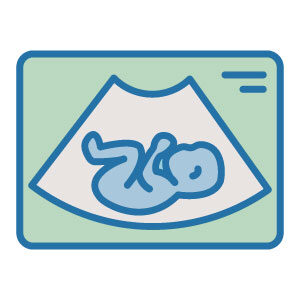FETAL CONDITIONS

A fetal ultrasound (sonogram) is an imaging technique using sound waves to produce images of a fetus in the uterus. Fetal ultrasound images can help a health care provider evaluate the baby’s growth and development and monitor the pregnancy. As maternal-fetal medicine specialists, we have a variety of different ultrasounds utilizing state-of-the-art technology that are available for enhanced screening in high-risk pregnancy situations.
Ultrasound has been used during pregnancy for decades and is considered safe when used appropriately. NO radiation is used during the procedure. Ultrasound is a tool that is constantly being improved and refined. While it can detect many problems during the pregnancy, it is not 100% accurate since what is seen is dependent on how the baby is positioned inside the mother.
Nuchal Translucency Ultrasound
This ultrasound is conducted during the first trimester between 11 and 13 weeks. It allows for an early look at the baby’s development and can detect some major birth defects or indicators of chromosome problems such as Down Syndrome. The nuchal translucency is the clear space located at the back of the baby’s neck. A thicker (larger) translucency may indicate an underlying chromosome problem or birth defect, which may necessitate further testing.
Detailed/Level 2 Ultrasound
This ultrasound is performed at about 20 weeks gestational age when structures are larger and can be more accurately evaluated. Common reasons for conducting a Level 2 ultrasound include family history of birth defects, maternal medical problems or exposure to medications associated with birth defects, advanced maternal age, or findings from the Nuchal Translucency ultrasound. The Level 2 ultrasound measures the head and abdomen size as well as the length of the arm and leg bones to determine if the baby is growing appropriately. The major structures in the baby’s head, chest, abdomen, and spine are also evaluated carefully to look for abnormalities. Possible birth defects identified from this ultrasound help determine viable treatments during the pregnancy or plans for care of the baby after delivery.
Fetal Echocardiogram
Like a Detailed/Level 2 ultrasound, a fetal echocardiogram allows a better view of the structure and function of the baby’s heart. The test is done if an ultrasound indicates a potential abnormality, there is a family history of heart disease, a prior child was born with a heart condition, or other factors. It is ideally performed between 24 to 26 weeks. Doppler ultrasound is used to evaluate the blood flow through the baby’s heart and across the different heart valves. Certain heart problems found during pregnancy may require additional evaluation by a pediatric heart specialist. Since oxygen-rich blood is delivered to the fetus from the placenta and the fetal lungs are not functioning during fetal life, the blood flow through the fetal heart is different compared to after birth. Therefore, a fetal echocardiogram cannot detect all problems with the heart prior to delivery.
Transvaginal Ultrasound
Also called an Endovaginal ultrasound, a wand-like device called a transducer is placed in the vagina. The procedure is typically less uncomfortable than a pelvic exam and is often used early in pregnancy for evaluating cervical shortening, determining the risk for preterm delivery, or gauging abnormal positioning of the placenta such as a placenta previa. Sometimes it is needed if the abdominal ultrasound did not provide sufficient information about the baby.
Fetal Doppler Ultrasound
Doppler ultrasound diagnoses problems during pregnancy using the same method a radar gun measures car speed. The ultrasound measures how fast blood is moving through the umbilical cord or various blood vessels within the baby. Abnormal results indicate the fetus is under greater stress.
Biophysical Profile
A BPP test is an ultrasound evaluation of the baby’s well-being during the third trimester. It is done if there is a question about the baby’s health, for example, decreased fetal movement or a fetal growth problem. Women with certain medical conditions such as diabetes and hypertension also rely on the BPP to provide reassurance that the baby is doing well. The BPP looks for fetal movement, tone (a reflex type movement), fetal breathing motion, and the amniotic fluid. The presence of all four of these during a 30-minute exam indicates that the baby is doing well, and the chance of a pregnancy loss is no greater than seen in a low-risk pregnancy. Because the health of a woman or fetus with a high-risk condition can change from week-to-week, this needs to be performed at least every seven days to provide the most reassurance.
